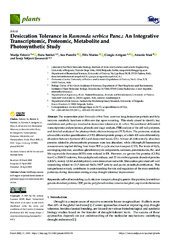Prikaz osnovnih podataka o dokumentu
Desiccation Tolerance in Ramonda serbica Panc.: An Integrative Transcriptomic, Proteomic, Metabolite and Photosynthetic Study
| dc.creator | Vidović, Marija | |
| dc.creator | Battisti, Ilaria | |
| dc.creator | Pantelić, Ana | |
| dc.creator | Morina, Filis | |
| dc.creator | Arrigoni, Giorgio | |
| dc.creator | Masi, Antonio | |
| dc.creator | Veljović-Jovanović, Sonja | |
| dc.date.accessioned | 2022-10-09T05:09:57Z | |
| dc.date.available | 2022-10-09T05:09:57Z | |
| dc.date.issued | 2022 | |
| dc.identifier.issn | 2223-7747 | |
| dc.identifier.uri | http://rimsi.imsi.bg.ac.rs/handle/123456789/1574 | |
| dc.description.abstract | The resurrection plant Ramonda serbica Panc. survives long desiccation periods and fully recovers metabolic functions within one day upon watering. This study aimed to identify key candidates and pathways involved in desiccation tolerance in R. serbica. We combined differential transcriptomics and proteomics, phenolic and sugar analysis, FTIR analysis of the cell wall polymers, and detailed analysis of the photosynthetic electron transport (PET) chain. The proteomic analysis allowed the relative quantification of 1192 different protein groups, of which 408 were differentially abundant between hydrated (HL) and desiccated leaves (DL). Almost all differentially abundant proteins related to photosynthetic processes were less abundant, while chlorophyll fluorescence measurements implied shifting from linear PET to cyclic electron transport (CET). The levels of H2O2 scavenging enzymes, ascorbate-glutathione cycle components, catalases, peroxiredoxins, Fe-, and Mn superoxide dismutase (SOD) were reduced in DL. However, six germin-like proteins (GLPs), four Cu/ZnSOD isoforms, three polyphenol oxidases, and 22 late embryogenesis abundant proteins (LEAPs; mainly LEA4 and dehydrins), were desiccation-inducible. Desiccation provoked cell wall remodeling related to GLP-derived H2O2/HO● activity and pectin demethylesterification. This comprehensive study contributes to understanding the role and regulation of the main metabolic pathways during desiccation aiming at crop drought tolerance improvement | sr |
| dc.language.iso | en | sr |
| dc.publisher | MDPI | sr |
| dc.relation | info:eu-repo/grantAgreement/ScienceFundRS/Promis/6039663/RS// | sr |
| dc.relation | info:eu-repo/grantAgreement/MESTD/inst-2020/200042/RS// | sr |
| dc.relation | The University of Padova (grant number BIRD189887/18 to G.A.) | sr |
| dc.relation | COST Action BM1405 (STSM-BM1405-190218-092344 and STSM-BM1405-190317-080965) | sr |
| dc.relation | The Ministry of Education, Youth and Sports of the Czech Republic with co-financing from the European Union (grant “KOROLID”, CZ.02.1.01/0.0/0.0/15_003/0000336) | sr |
| dc.relation | info:eu-repo/grantAgreement/ScienceFundRS/Promis/6039663/RS// | sr |
| dc.relation | The Italian Ministry for Education, University and Research (project number PRIN 2020HB9PR9_005) | sr |
| dc.rights | openAccess | sr |
| dc.rights.uri | https://creativecommons.org/licenses/by/4.0/ | |
| dc.source | Plants | sr |
| dc.subject | cell wall remodeling | sr |
| dc.subject | cyclic electron transport | sr |
| dc.subject | drought | sr |
| dc.subject | germin-like proteins | sr |
| dc.subject | late embryogenesis abundant proteins | sr |
| dc.subject | OJIP | sr |
| dc.subject | pectin | sr |
| dc.subject | polyphenol oxidase | sr |
| dc.subject | resurrection plant | sr |
| dc.subject | superoxide dismutase | sr |
| dc.title | Desiccation Tolerance in Ramonda serbica Panc.: An Integrative Transcriptomic, Proteomic, Metabolite and Photosynthetic Study | sr |
| dc.type | article | sr |
| dc.rights.license | BY | sr |
| dc.citation.issue | 9 | |
| dc.citation.rank | M21 | |
| dc.citation.spage | 1199 | |
| dc.citation.volume | 11 | |
| dc.identifier.doi | 10.3390/plants11091199 | |
| dc.identifier.fulltext | http://rimsi.imsi.bg.ac.rs/bitstream/id/3821/Desiccation-Tolerance-in-Ramonda-serbica-Panc-An-Integrative-Transcriptomic-Proteomic-Metabolite-and-Photosynthetic-StudyPlants.pdf | |
| dc.type.version | publishedVersion | sr |

